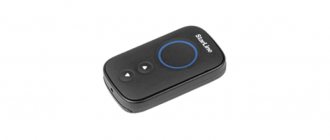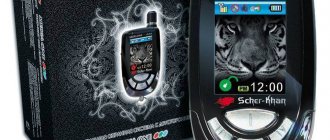02/26/2022 1,731 Alarms
Author: Victor
In various models of the Mongoose anti-theft complex, communicators with 2, 4, 5 or key fobs with 3 buttons can be used as a radio transmitting device. The instructions for the Mongoose alarm indicate that the remote control processors independently change the type of radio commands to protect against electronic hacking. Regardless of the number of keys, the signals are generated anew each time they are pressed, which makes the system resistant to interception by code grabbers.
[Hide]
Specifications
Description of the main characteristics and properties of Mongoose 43392 MHz car security systems:
- To power the anti-theft “signaling” module, a voltage in the range from 9 to 15 volts is required. The best option would be to use car alarms on vehicles with a 12-volt on-board network.
- When the security mode is on, the current consumption is no more than 20 mA.
- Data transfer between the transceiver and the communicator when sending commands is carried out over a radio channel with a frequency of 433.92 MHz.
- The range of the additional car alarm remote control is no more than 30 meters.
- To ensure uninterrupted operation of the microprocessor module, the air temperature should be from –40 to +85 degrees.
- The operating radius of the pager in the signal sending mode will be no more than 1 km. When receiving messages, this figure will increase to 2 km. Please note that this value is calculated by the manufacturer under ideal operating conditions for the car alarm. If the area is characterized by the presence of dense architecture and buildings, as well as transformer substations, then this indicator will be several times lower. It is affected by weather conditions and the discharge of the battery in the key fob.
Despite the possibility of the alarm operating on a 9-volt power supply, the use of Mongoose systems is not allowed on motorcycles. This is due to the fact that at a voltage of 9 V the system can operate for a short time, no more than a few minutes.
The control module of the security complex is designed to work with currents of the following magnitude:
- to block engine start and ignition system - 30 amperes;
- electrical circuit for remote engine start - 30 A;
- emergency light line or marker optics - 10 amperes;
- control circuits for drive devices or central locking - 15 amperes for older cars and 300 mA for modern models;
- to power additional channels designed to control auxiliary equipment and devices, no more than 300 mA will be required.
Characteristics of key fobs
The Mongoose alarm, depending on the type and model, can be equipped with remote controls with a different number of keys:
- 2-button devices are supplied in a round plastic case. On the front side of the communicator there are two controls and an LED indicator that functions when transmitting code and commands. The pager is equipped with a 23 A battery, which has a service life of at least 12 months. In Mongoose 600 models, elements of the CR2016 standard, rated at 3 volts, are used to power the key fob. The devices have a unique signal encryption technology - the code changes with each subsequent command sent from the remote control.
- Remote controls with three control elements are included in the delivery package of the Mongoose 800 security installation. The devices are supplied in an elongated plastic case. The pager is equipped with two CR2016 class batteries.
- Four-button devices are included in the Mongoose 770 or 900 alarm system. The product body is based on the design of key fobs with two keys. The main difference is the presence of additional holes on the middle part of the device. The Mongoose B001 and B003 security complexes use remote controls with a liquid crystal screen that can operate in feedback mode. The devices are powered by AAA batteries rated at 1.5 volts.
- Communicators with 5 control elements are included in the delivery package of the Mongoose Boomerang Premium and 1.9 EMS alarm systems. The devices can operate in feedback mode. Visually, the communicator is similar to the key fob for the 750 model. The pager screen is equipped with a diode backlight system, which simplifies the control procedure in the dark. Protection of transmitted signals is achieved through the use of AM modulation.
How to install?
When installing Mongoose systems, you must adhere to the following rules:
- Before starting installation, disconnect the battery from the on-board network (remove the terminals).
- The alarm unit, containing a control processor and distribution relays, is installed inside the car in a hard-to-reach place, isolated from sources of heat and moisture.
- The antenna of the radio receiver module is located at the maximum possible height. The receiver is installed on the windshield, away from metal body parts and electrical wiring harnesses. The manufacturer does not recommend making changes to the design of the device or changing the length of the standard wire, as this causes a decrease in the operating range of the control panels.
- The siren is mounted in a place inaccessible to an attacker. The standard installation location is the engine compartment; the device is placed on the engine shield or mudguards with the horn facing down. The location should ensure that the device is protected from flooding and overheating.
- If you plan to use a self-powered siren, then you need to provide access to the lock cylinder, which is used to turn off the device.
- The installation locations of signal breakers (limit switches) of the trunk and hood lids are located at points that provide maximum protection from moisture. It is forbidden to install devices in drainage channels, since in this case the operation of the limit switch is disrupted and moisture can enter the internal cavities of the body.
- The impact sensor is placed only inside the passenger compartment, closer to the longitudinal axis (to ensure uniform susceptibility to impacts). The device must be placed on metal body panels and firmly fixed with self-tapping screws or adhesive tape. Rigid installation reduces the likelihood of false signals from the sensor and provides vehicle protection.
- The power supply wires of the system and the terminals to the actuators are protected by fuses designed to operate with currents of the appropriate strength.
- Wire connections must ensure reliable contact.
- The negative terminals of the harnesses are attached to the ground bolts and nuts on the car body.
- Wire connections should be insulated with tape or heat shrink tubing.
Equipment
The car alarm package includes the following items:
- Electronic control module. With it you can program basic settings and functions. The unit is equipped with a processor and is the “brain” of the car alarm; it is sold in a black plastic case.
- Siren with a bracket for fixing in the engine compartment.
- Sensitivity and shock sensor. The device belongs to the category of two-level controllers. Equipped with a cable with a connector for connection.
- Set of harnesses with wires for connection.
- Main communicator. The number of control buttons will vary depending on the model. The main pager is equipped with a screen, which can be used to provide feedback.
- Spare remote control. The number of controls is determined by the model. The additional communicator is not equipped with a display.
- LED designed to determine the status of a car alarm.
- Button to enter the service mode of system maintenance.
- A set of mounting elements and fasteners for connecting an alarm system.
- Limit switch for installation on the hood and protection of the engine compartment from burglary.
- Service manual for installing, connecting and disabling the alarm. Using the documentation, the user can program the basic options, as well as connect all the elements of the anti-theft system. For this purpose, the manual includes a special diagram.
The package may include a volume sensor related to two-level devices. With its help, the system will be able to detect the presence of any movements in the car interior or near the body.
The Mongoose package does not include triggers for door locks and the trunk; these devices must be purchased additionally.
Alarm equipment Mongoose
Setting up autorun
Activating autorun can be done in several ways:
- From the keychain. To do this, briefly press the M and 1 buttons. The corresponding indicator will appear on the screen. The duration of the motor operation is set in the programming menu.
- By time. The setup begins by simultaneously pressing the M and S keys located on the side of the remote control. After this, an indicator appears showing the time. Change the value using buttons 1 and 2. Use button 3 to confirm the selection of the parameter. A sound signal notifies you that the procedure was performed correctly.
- By temperature. Use the M and S keys to enter the programming menu. The warm-up time is selected by pressing buttons 1 and 2. After that, hold down the M key for 3 seconds.
Key Features
Features and functions of Mongoose alarms:
- Control of the security mode with or without confirmation sounds. If necessary, the user can activate silent vehicle protection. When the alarm is turned on, the siren will not sound, but information about turning on the mode will be sent as a message to the communicator.
- Automatic activation of the car security mode. The user can configure the system so that protection will be activated if it is accidentally disabled. The alarm system will be able to recognize this by analyzing the signals from the door triggers.
- The ability to change sensitivity, as well as remote control of the shock sensor and other controls. The device is configured using a communicator.
- "Search" for a car. Thanks to this function, the user can activate the operation of external lighting devices by command. This will allow you to find a vehicle left in a large parking lot.
- Availability of a control system to prevent false alarms.
- Self-diagnosis of the alarm system when arming, as well as bypassing faulty zones. When the protection mode is turned on, the system checks all components. If one of them turns out to be inoperative, the alarm will automatically turn it off. Information about this will be provided to the consumer in the form of a message on the remote control.
- Disabling protection mode in two stages. First, the user deactivates the door lock operation with the pager, and then enters a personal code to disable it. The latter can be used to enter the alarm service mode.
- Availability of built-in memory of system activations. If an alarm goes off in security mode and the key fob is outside the antenna coverage area, a message will be sent when it appears within range. The remote control screen will display information about the activation of the siren, indicating the triggered protection zone.
- Engine blocking when dismantling the system. If the thief decides to physically disable the control unit or other components of the alarm, this will lead to problems starting the engine. The ignition circuits will remain blocked and no further connection will be possible.
- The ability to control additional electrical equipment, for example, a sunroof, folding mirrors, power windows, etc. The main thing is that the devices are equipped with electric drives and are connected to the microprocessor module of the system. The equipment is controlled using additional channels; their number, depending on the model, can be 2–4.
- Setting up a signal for working with central locking (CL). You can enable a pulse delay of 0.8–30 seconds.
- The presence of a key fob energy saving mode. With its help, you can prevent the rapid discharge of batteries and replace them in a timely manner. When energy saving is turned on, the pager function, that is, the mode of notifying about the operation of the alarm by messages to the remote control, is temporarily disabled.
- Engine operation control. The latest versions of the Mongoose may have an engine autostart function, with which the power unit can be started remotely, without the presence of the car owner. A convenient option for the winter season, when it takes several minutes to warm up the engine.
- Vibrate alert. Activating it will allow you to disable sound alerts coming to the remote control. Instead, vibration mode is activated.
Video: capabilities and features of Mongoose systems
The channel “atlantis3570” talked about the functional features of Mongoose alarms using the example of the Digital 100 model.
Functions
The Mongoose alarm has the following functionality:
- silent activation of anti-theft mode;
- automatic entry of the system into protective mode;
- turning on the alarm mode (activated after receiving data from the shock sensor);
- signal coding that prevents hacking using modern technical means;
- intelligent prevention of false positives;
- automatic shutdown of faulty sensors;
- two-stage disarming of the system;
- storing trip data in non-volatile memory;
- control of the driver's seat, mirrors, climate control system (alarm system in some models);
- setting up central locking control;
- ability to connect an immobilizer, GSM module and other auxiliary devices;
- manual control of the functioning of the central lock;
- Restoring user settings after a power failure.
How the Mongoose alarm works
The principle of operation of the Mongoose security system using the example of any model with auto start:
- Control is carried out using a communicator. In accordance with the instructions for the key fob with 3-5 alarm buttons Mongoose, when you press the keys, the device sends a code. If the command is to arm the security, the signal is sent to the transceiver and the control unit, which processes it and transmits it to the actuators. If the pulse does not arrive, the remote control's pager may be out of range of the antenna.
- Triggers or limit switches are actuators. When receiving a command from the control unit, they close the connected locks on the doors, hood and trunk. Security mode is activated. Activation of the shock controller, depending on the setting, can occur immediately or after a certain interval (30–60 seconds).
- When operating in security mode, the alarm protects the main areas of the vehicle. These are locks on body elements, free space around it (if there is a volume controller), a starter device, and power circuits of the ignition system. If the sensor detects weak physical impacts on the body, it sends a command to the siren through a microprocessor, which turns on warning signals. For more serious impacts, an alarm is activated.
- If the engine starts automatically, the ignition system relay is turned on when the doors are closed. The contacts of the starter electrical circuits, necessary to start the engine, close, which leads to the crankshaft cranking mechanism. If the power unit starts successfully, the signal should be sent to the car owner’s remote control. The starter operating time to start the engine is programmable by the user.
- When sending a command to disable the security, the signal is also sent to the control unit via the antenna. After processing, the door locks, shock sensor and other controllers, engine blocking, etc. are deactivated. The security mode is disabled, you can start the engine. But if no door opens within 30–60 seconds (auto-lock setting), all locks will close and the auto security function will be activated.
Functional
This system uses a signal encoding program. Each time the encoding changes, and it is impossible to trace the algorithm of changes. This allows you to completely eliminate the reading of codes by grabbers.
Arming the vehicle is done by pressing one button. At the same time, you should pay attention to the following signs of a successful staging. The car will flash its hazard lights and lights once. After this, the control LED (usually mounted under the windshield) begins to blink. If there are central locks, they will close. When the doors cannot be closed, a triple signal will sound. Disarming is also done by pressing the same button (1). The system's response to shutdown can be judged by a double signal.
When the systems are in security mode, all access zones connected to the control unit are monitored. If the integrity of any of these zones is violated, the “alarm” mode is triggered. The engine is blocked, the alarm system (sound and light) is turned on. A signal is also sent to the owner's key fob. In situations of unplanned activation, for example, someone accidentally touched the car, the “alarm” will turn off in 30 seconds, but the motor blocking will remain.
Sometimes you need to turn on the security system without sound. Button 2 is intended for this. By pressing it, you will see standard signals when turning on systems, but they will not be accompanied by sound. In the same way, you can silently shut down the system.
Sometimes it is necessary to set the car under security with the sensors turned off. For example, when there are animals in the cabin. In this case, press button 1 twice.
Advantages and disadvantages
Description of the advantages of anti-theft systems Mongoose:
- Affordable cost of alarms, low price for the domestic market compared to other manufacturers.
- Versatility. The use of an anti-theft system is permitted on vehicles with manual and automatic transmissions, regardless of engine type. The alarm can work with different types of drive devices for blocking door locks.
- Large range of adjustments for the sensitivity sensor. This will avoid false alarms when the alarm responds to strong winds or cars passing by.
- An easy-to-use communicator.
Consumer reviews also point out disadvantages:
- Less modern versions of Mongoose alarms do not have extensive functionality. They are deprived of the ability to autostart the engine, two-way communication with cars and other options.
- The anti-theft system may not operate correctly at low negative temperatures or when there is a voltage drop in the electrical network. A discharged battery can cause the engine to lock up, which will not turn off until the battery is charged. Low air temperature causes the alarm to respond longer to commands sent from the remote control.
- High power consumption of a two-way communicator. The battery discharges quite quickly during initial setup and frequent use of additional functions.
- Some users note the disadvantage of a dim screen backlight and a difficult to read display. This may be due to the battery in the key fob being low. You can get used to the indicators on the remote control display over time.
Video: why Mongoose alarms are harmful
The channel “Aleksej Z AVTOREMONT” in its video talked about one of the shortcomings that the owner of a Mongoose alarm system may encounter.
Diagnostics
If during the security cycle any one sensor is triggered 8 times, it will turn off. At the same time, the rest of the system will continue to operate as before. An attempt to activate the alarm when the door is open is accompanied by 3 short beeps. If the alarm mode was turned on during system operation, then when you remove the car from protection, you will see a series of 4 signals.
When handing over the car for service, it is recommended to turn on the Valet mode. This will eliminate the recording of additional key fobs. In this case, the protective functions will be disabled.
Conclusion
. A modern car has quite complex security systems. In order not to get confused in the functions, the instructions for the Mongoose alarm, key fob with 3 buttons, should be studied by you in advance. This will allow you to avoid problems during the operation of the security complex.
Alarm installation
Before installing a car alarm, the user must perform the following steps:
- Turn off all electrical equipment in the car.
- Turn off the ignition.
- Make sure that all electronic components, as well as the battery, are working properly.
- Disconnect the on-board network. To do this, the negative terminal clamp is disconnected from the battery.
Photo gallery: general alarm connection map
The third example of a wiring diagram for connecting the anti-theft system Mongoose
The second example of a wiring diagram for connecting the anti-theft system Mongoose
An example of a wiring diagram for connecting the anti-theft system Mongoose
The fourth example of a wiring diagram for connecting the anti-theft system Mongoose
Installation instructions
Installation of the anti-theft system is carried out as follows:
- A control module is installed inside the car. It is recommended to install it as discreetly as possible, in a place not exposed to moisture, high temperatures and other external factors. It is better to install the unit behind the instrument panel, this will ensure a minimum length of wires when connecting. The microprocessor should be placed on a flat surface using self-tapping screws or plastic ties and additionally wrapped with cellophane and foam rubber. This will prevent the negative impact of vibrations, and to prevent moisture from entering, the module should be placed with the connector facing down.
- The siren is installed in the engine compartment with the horn facing down to prevent condensation from accumulating inside. The device is mounted on a special bracket away from the cylinder block and metal parts adjacent to it. Wires are laid through a special hole in the technological partition separating the interior from the engine compartment.
- The transceiver with antenna is installed on the car window. The working surface of the glass must be cleaned and degreased in advance. It is not allowed to install the transceiver near metal products; this may lead to deterioration in the quality of the transmitted signal. The wire from the antenna adapter must not be twisted into coils, as this will cause interference when sending commands.
- Limit switches are installed on all doors, hood and luggage compartment of the car. Their installation should not be carried out in drains or places where moisture accumulates.
- The button to enter the service mode is located in the car's interior, most discreetly. It is recommended to install it under the instrument panel so that the user has access to it when he is in the driver's seat.
- The sensitivity sensor and additional regulators are installed inside the car, in the central part of the body. For installation, you can choose a metal partition with the engine compartment. During installation, it must be taken into account that the regulators must be freely accessible.
- At the final stage, all system components are connected. Negative outputs must be connected to ground, that is, ground. To do this, you can use any standard bolts screwed into the car body.
Additional functionality
For guaranteed protection against theft, there is a state memory. That is, the system remembers the protection states at the time of power outage. If you remove and then put on the battery terminal, the “panic” mode will automatically activate and the motor will remain blocked. When the alarm is disabled, interrupting the power supply will not change the status. The systems use two-step deprotection of vehicles. When the door opened, or the sensor simply reacted to movement, the first press of the button will simply turn off the siren; to turn off the alarm, you need to press the button again.
The owner is protected from accidental disconnection of the car from security. If within 30 seconds after removal, no door is opened, the alarm will return to security mode. It is possible to enable auto-arming. After turning off the ignition and closing the doors, the alarm will turn on in the next 30 seconds.
User manual
Before using the alarm, you must make sure that all components are connected correctly. To do this, restore the voltage in the car's electrical network by reconnecting the battery terminals. Then you need to turn the security mode on and off, making sure the door locks are locked. It should activate and deactivate accordingly.
Key fob button diagram
The pattern of the Mongoose key fob may differ depending on the model of the anti-theft system.
Scheme of buttons on the Mongoose keychain
Purpose of the main key fob buttons
The purpose of the controls may vary depending on the number of keys on the pager. Before using the communicator, a working battery is inserted into the device. The battery is installed in a special compartment hidden behind the back cover of the pager. The battery must be inserted taking into account the polarity.
Table: commands executed according to the instructions of the Mongoose alarm key fob with 3 buttons
| Button number | Option | Note |
| 1 | Activating vehicle protection mode | The ignition in the car must be turned off |
| 1 | Enabling the security function with the shock sensor and additional controllers disabled | The button is pressed twice with an interval of no more than three seconds |
| 1 | Enabling door locks | Pressing the key after ignition activation |
| 1 | Controlling the “Panic” option | To enable the function, press the control element for three seconds with the ignition off |
| 1 | Turn on the Search feature | The button is pressed twice. The option can be used when the security mode is on or when protecting the vehicle with the engine running. |
| 1 | Activation of the “Anti-robbery” mode | When the ignition is on, the control element is pressed for three seconds |
| 1 + 3 | Silent car security | The third key is pressed first, and then the first. The ignition in the car must be turned off. |
| 1 + 3 | Silent activation of the security mode with the shock sensor disabled and additional controls | Button 3 is pressed briefly, then the first key is “clicked” twice. The ignition in the car must be turned off. |
| 1 + 3 | Arming a vehicle with the power unit running | The third key is pressed for three seconds, then button 1 is briefly pressed. The ignition in the car must be turned on. |
| 1 + 3 | Activation and deactivation of silent machine protection, without siren signals | Double tap on controls |
| 2 | A short press will disable the security mode, as well as alarm signals. | |
| 2 | Turning off the security function and opening door locks | The option to unlock doors in two stages must first be configured. The click must be double. |
| 2 | Disabling door locks | The ignition in the car is active |
| 2 + 3 | Silent deactivation of the security mode | The third key is pressed first, then the second |
| 3 | Opening the tailgate | Double “click” provided that an additional control channel is connected |
| 3 | Support for the operation of the ignition system when the “Turbo timer” mode is operating | Pressing the button for three seconds with the ignition active |
Table: description of commands executed using the remote control using the example of the Mongoose 900 model
| Button press | Function | Note |
| 1 | Activating protection mode in the car | Short press for 0.5 s |
| 1 | Enabling Panic mode | Long press on a control for two seconds |
| 1 + 2 | Controlling the machine protection function without siren signals | Brief "click" |
| 1 + 3 | Entering the service mode for servicing the anti-theft system | Likewise |
| 1 + 4 | Closing the door locks after activating the ignition system | Likewise |
| 1 + 2 | Activating silent protection mode | Long press on a control for two seconds |
| 1 + 3 | Enabling daily automatic engine start | Likewise |
| 1 + 4 | Entering the alarm options programming menu | Likewise |
| 1 + 2 | Setting the clock on the key fob | Press and hold the key for four seconds |
| 1 + 3 | Entering the menu for setting the start parameters of the power unit during daily start | Holding the buttons for 4 s |
| 2 | Disabling the car security mode | Short press |
| 2 | Remotely starting or stopping a car engine | Press for two seconds |
| 2 + 3 | Enabling the option to automatically arm the car | Short press |
| 2 + 4 | Calling the car owner from the salon | Short "click" |
| 2 + 3 | Starting a car's power unit based on temperature | Press for two seconds |
| 2 + 4 | Periodic engine start using a timer | Likewise |
| 3 | Entering the setup menu for the second additional channel | Short press |
| 3 | Opening the tailgate | Press for two seconds |
| 4 | Diagnostics of all components of the alarm system and request information about air or interior temperature | Hold for 2 s |
| 3 + 4 | Entering the shock sensor settings menu | Likewise |
| 3 + 4 | Activating and disabling the “Turbo timer” option | Likewise |
Table: assignment of buttons in model B001
| Button number | Function description | Note |
| 1 | Enabling security mode | The ignition in the car must be turned off |
| 1 | Activating vehicle protection with the shock sensor and other controls disabled | The button must be pressed twice. The interval between “clicks” will be no more than three seconds. The ignition in the car is turned off. |
| 1 | Enabling door locks | The ignition in the car is active |
| 1 | Activating and disabling Panic mode | Holding the control element for three seconds with the ignition system turned off |
| 1 | Enabling the “Search” option for a vehicle | Double click. The standard security mode or protection with the engine running must be turned on. |
| 1 | Activation of the “Anti-robbery” mode | The button is pressed and held for three seconds. The ignition in the car must be turned on. |
| 1 + 3 | Silent activation of security mode | The third key is pressed first, and then the first. The ignition in the car is turned off. |
| 1 + 3 | Silent activation of protection when controllers are disabled | First, press button 3, and then press 1 twice. The ignition in the car is turned off. |
| 3 + 1 | Arming a car with the engine running | Key 3 is pressed for three seconds, then the first button is “clicked” briefly. The ignition in the car is active. |
| 1 + 3 | Activating and disabling silent car protection | Double taps |
| 2 | Turning off alarms when the siren is activated | Short press |
| 2 | Disabling car security | Likewise |
| 2 | Deactivating the security mode and unlocking all locks or the driver's door | The corresponding two-stage disarming option must first be configured |
| 2 + 3 | Silent disabling of car security | Press the third key briefly, and then the second |
| 2 | Disabling door locks | With the ignition on |
| 4 | Opening the tailgate | Double click on the button. The additional channel must first be turned on. |
| 4 | Support for the operation of the ignition system for the functioning of the “Turbo timer” mode | When the ignition is activated, the button is pressed twice |
Table: description of commands executed using the five-button key fob Mongoose EMS
| Button number | Description | Note |
| 1 | Enabling security mode | Ignition off |
| 1 | Setting up car protection with disabling controllers and regulators | Press twice within three seconds. The car's ignition is turned off. |
| 1 | Arming with deactivation of the shock sensor warning zone | Consecutive pressing twice |
| 1 | Silent activation of protection mode | Ignition disabled |
| 1 | Arming a car with the engine running | Press the first button twice within three seconds |
| 1 | Quiet vehicle protection | The first key is “clicked” twice briefly. The ignition in the car is turned on. |
| 2 | Disabling security mode | Short press |
| 2 | Silent shutdown of the protective option | Double click on a key within three seconds |
| 2 | Opening door locks | Briefly press the button with the ignition on. The passive engine immobilizer must be disabled. |
| 1 | Activating Panic mode | Press and hold a control for three seconds |
| 2 | Opening the tailgate | Double click on the button for 3 seconds |
| 2 | Entering alarm service mode | Press and hold the control for three seconds |
| 3 | Activating the transceiver communication test function | Short press when protection mode is on |
| 3 | Entering the menu for setting engine autostart parameters using a timer | Hold down the key for three seconds |
| 3 | Activation of periodic start of the power unit | Double click on a control |
| 4 | Enabling the key lock feature on your pager | |
| 4 | Activating the screen backlight option, as well as diagnosing the parking timer | |
| 4 | Controlling siren signals on and off | |
| 4 | Activating and deactivating the communicator vibration mode | |
| 5 | Setting the start parameters of the power unit based on air temperature readings | Hold for three seconds with ignition off |
| 5 | One-time remote engine start | Short press |
| 5 | Remote machine engine stop | Likewise |
Photo gallery: devices with different numbers of controls
Buttons on the communicator Mongoose 800
Mangoose 900 key fob controls
Designation of buttons on the key fob with feedback Mongoose B001
Photo of the keys on the communicator for control model Mongoose 1.9 EMS
How to program key fobs
Using all alarm options is possible after the user manages to register a new pager into the memory of the control unit. Without this, operation of all functionality will be impossible.
Mongoose 750 and 770
To “flash” the remote control on the Mongoose 750 and 770 alarm systems, perform the following steps:
- When the security mode is turned off, the ignition system is turned on.
- Using the service button, you enter a personal password if it is enabled. Then the ignition system is turned off and activated. If the code consists of two digits, after switching on, the next character is entered.
- The siren should emit a double beep. If it works, this indicates that the alarm system is ready to reflash the key fobs.
- On the device being registered, press the first button. A siren will sound to confirm the binding. The remaining communicators are programmed in the same way.
- After binding, the ignition in the car is turned off, after which the service mode button is pressed.
The Mongoose alarm control unit allows you to register up to four devices in memory. When programming the first remote control, information about the communicators is deleted from the microprocessor.
Mongoose 700 and 800
Linking versions 700 and 800 is done like this:
- The car's ignition is turned on. The service mode entry button is pressed five times within ten seconds.
- The siren will emit one signal. After this, any button on the connected device is pressed.
- The ignition in the car turns off. Ten seconds after this, the alarm will exit the binding mode. The siren will emit a beep as confirmation.
If the system is configured to bind using a personal code, the following steps are performed for programming:
- The ignition in the car is activated, turned off and turned on again.
- Within ten seconds, use the service button to enter the first digit of the password.
- The ignition in the car is turned off and activated.
- The second digit of the code is entered in the same way.
- The ignition turns off and on. If the code is entered correctly, the siren will emit one signal. Then, within ten seconds, the user must press the service button three times. Another beep will sound as confirmation.
- Any button can be pressed on the registered communicator. The siren will sound once upon successful binding.
The remaining communicators are programmed in the same way. To exit the binding menu, the ignition in the car is turned off.
Video: Mongoose AMG 700 recoding
User Alexey Poluboyarinov in his video, using the Mongoose 700 model as an example, showed the process of programming a new key fob.
Mongoose 400
In Mongoose 400 Base systems, binding is done as follows:
- The ignition in the car is activated and turned off three times within seven seconds. The key must be left in the lock in the "ACC" position.
- The status LED will start blinking. After a three-second series of rapid flashes, rhythmic flashing will begin.
- The user must count the number of blinks corresponding to the value of the personal password. Then the ignition in the car is turned off.
- The key in the lock is turned to the “ACC” position. The first button on the pager is pressed.
- The ignition in the car turns off (it can be left in this state if the programming process is completed).
Mongoose EMS-1.9
Linking the Mongoose EMS-1.9 key fob is done as follows:
- The car's ignition is activated. Using the service button, a password is entered; the number of presses must correspond to the number of the code.
- The ignition in the car turns off and turns on again.
- On the registered communicator, the first key is pressed. To confirm successful binding, the siren will emit a short signal.
- To leave the setup menu, the ignition is turned off and the service mode entry button is pressed once.
Setting up the autostart system
Before setting up autostart, the vehicle is prepared:
- On a car with the engine running, the handbrake is raised. All car doors must be closed. The transmission selector must be set to neutral.
- The ignition is turned off and the key is removed from the lock. The engine will remain running.
- The driver leaves the car and closes all doors. The security mode is activated. This will cause the motor to stop.
To start the power unit remotely on the 1.9 EMS model, press the fifth button, and then briefly “click” the first. The interval between presses should be no more than three seconds. In B001 models, the launch is activated by pressing the second and then the fourth pager keys.
Automatic engine start by time on version 1.9 EMS:
- You enter the setup menu by simultaneously pressing buttons 4 and 5. A flashing display will appear on the key fob display, displaying the current time.
- Using the first and second controls, the clock parameters are changed up or down.
- To go to the minutes setting menu, use the third key. Changing parameters is done in the same way, using the first or second buttons. After selecting the parameters, press key 3. To confirm the setting, the key fob will sound a melodic signal.
Automatic engine start on time with alarm B001 is configured as follows:
- The first and third keys of the key fob are pressed and held for four seconds.
- The hours and minutes parameters are changed using buttons 1 and 2. After setting the values, controls 1 and 3 are “clicked” simultaneously. The time indication will appear on the display.
- The first and third buttons are pressed and held. This will activate the autorun option. A corresponding icon will appear on the display as confirmation.
How to turn off the alarm
An emergency alarm shutdown using the model 770 as an example looks like this:
- The driver's door is opened with a key. This will activate the alarm mode. The siren will sound, as well as the car's external lighting devices.
- The ignition system turns on.
- Using the service button, a password is entered. After specifying the code, the ignition is turned off. The number of button presses must correspond to the password number.
- When using a two-digit code, you need to turn on the ignition and repeat the procedure.
Mongoose 4 Button Remotes
Four-button key fobs Mongoose belong to the executive class of anti-theft devices. They come complete with the following alarms:
- MCA 500;
- MAP70R2;
- EMS0 (as an additional key fob);
- 800C Duplex;
- 770 Duplex 2-1 RKT-09S.
The first button activates the security function. In addition, you can use it to find vehicles in the parking lot and turn on the “Panic” mode. The second controls the doors and adjusts the intensity of the security and alarm signals. The third button is designed to silently activate the security system and automatically start the engine. The function of the fourth is to adjust the turbine timer and remotely open the luggage compartment.
Download installation and operating instructions in PDF format
You can download service manuals for alarm management and installation using the following links:
| Manuals in Russian for operation and installation of alarm systems | |
| Operating and installation instructions MONGUST 700 | |
| Operating and installation instructions MONGUST 750 | |
| Operating and installation instructions MONGUST 770 | |
| Operating and installation instructions MONGUST 400 Base | |
| Operating and installation instructions MONGUST 800 | |
| Operating and installation instructions MONGUST 1.9 EMS |
Video: code grabber and Mangoose EMS
The “carunlock” channel in its video showed how you can hack a Mongoose alarm using a code grabber.
Do you have any questions? Specialists and readers of the AUTODVIG website will help you ask a question
Was this article helpful?
Thank you for your opinion!
The article was useful. Please share the information with your friends.
Yes (100.00%)
No
X
Please write what is wrong and leave recommendations on the article
Cancel reply
Rate this article: ( 2 votes, average: 5.00 out of 5)
Discuss the article:











